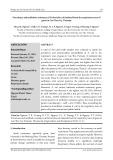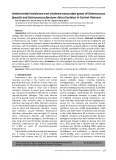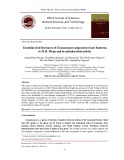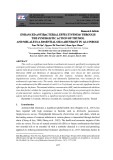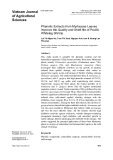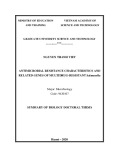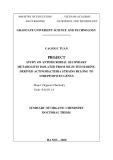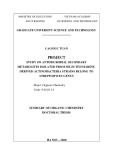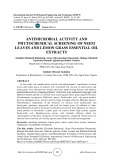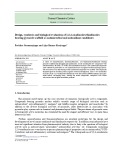The shell matrix of the freshwater mussel Unio pictorum (Paleoheterodonta, Unionoida)
Involvement of acidic polysaccharides from glycoproteins in nacre mineralization Benjamin Marie1, Gilles Luquet1, Jean-Paul Pais De Barros2, Nathalie Guichard1, Sylvain Morel3, Ge´ rard Alcaraz3, Loı¨c Bollache1 and Fre´ de´ ric Marin1
1 UMR CNRS 5561, Bioge´ osciences, Universite´ de Bourgogne, Dijon, France 2 U 498 INSERM, Me´ tabolisme des lipoprote´ ines humaines et interactions vasculaires, Universite´ de Bourgogne, Dijon, France 3 UMR INRA 692, Biochimie des interactions cellulaires, ENESAD, Dijon, France
Keywords biomineralization; calcium-binding protein; glycoprotein; matrix macromolecules; mollusc shell nacre
Correspondence B. Marie, G. Luquet, or F. Marin, UMR 5561 CNRS, Bioge´ osciences, Universite´ de Bourgogne, 6 boulevard Gabriel, F-21000, France Fax: +33 3 80 39 63 87 Tel: +33 3 80 39 63 72 E-mail: benjamin.marie@u-bourgogne.fr, gilles.luquet@u-bourgogne.fr, frederic.marin@u-bourgogne.fr
(Received 27 December 2006, revised 13 March 2007, accepted 10 April 2007)
doi:10.1111/j.1742-4658.2007.05825.x
Among molluscs, the shell biomineralization process is controlled by a set of extracellular macromolecular components secreted by the calcifying mantle. In spite of several studies, these components are mainly known in bivalves from only few members of pteriomorph groups. In the present case, we investigated the biochemical properties of the aragonitic shell of the freshwater bivalve Unio pictorum (Paleoheterodonta, Unionoida). Ana- lysis of the amino acid composition reveals a high amount of glycine, as- partate and alanine in the acid-soluble extract, whereas the acid-insoluble one is rich in alanine and glycine. Monosaccharidic analysis indicates that the insoluble matrix comprises a high amount of glucosamine. Further- more, a high ratio of the carbohydrates of the soluble matrix is sulfated. Electrophoretic analysis of the acid-soluble matrix revealed discrete bands. Stains-All, Alcian Blue, periodic acid ⁄ Schiff and autoradiography with 45Ca after electrophoretic separation revealed three major polyanionic cal- cium-binding glycoproteins, which exhibit an apparent molecular mass of 95, 50 and 29 kDa, respectively. Two-dimensional gel electrophoresis shows that these bands, provisionally named P95, P50 and P29, are composed of numerous isoforms, the majority of which have acidic isoelectric points. Chemical deglycosylation of the matrix with trifluoromethanesulfonic acid induces a drastic shift of both the apparent molecular mass and the isoelec- tric point of these matrix components. This treatment induces also a modi- fication of the shape of CaCO3 crystals grown in vitro and a loss of the calcium-binding ability of two of the main matrix proteins (P95 and P50). Our findings strongly suggest that post-translational modifications display important functions in mollusc shell calcification.
[1]. All
mineral precursors these components are released in the extrapallial space, where they are sup- posed to self-assemble in an orderly manner. The mat- rix may have several functions: it organizes spatially a 3D framework, concentrates locally mineral ions above
Among molluscs, the shell biomineralization is a matrix-mediated process, performed extracellularly. This matrix is a complex mixture of proteins, glyco- proteins, polysaccharides and lipids, which are secreted by the mantle calcifying epithelium, together with the
Abbreviations AIM, acid-insoluble matrix; ASM, acid-soluble matrix; BCA, bicinchoninic acid; CBB, Coomassie Brilliant Blue; DMB, 1,9-dimethylmethylene blue; IEF, isoelectric focusing; IPG, immobilized pH gradient; PAS, periodic acid ⁄ Schiff; TFMS, trifluoromethanesulfonic acid.
FEBS Journal 274 (2007) 2933–2945 ª 2007 The Authors Journal compilation ª 2007 FEBS
2933
B. Marie et al.
Characterization of the shell matrix of freshwater mussel
saccharidic composition, and underline the importance of the role of glycosyl moiety in the nacre mineraliza- tion process.
Results
the supersaturation threshold, catalyzes mineral preci- pitation, nucleates crystals, determines the polymorph at crystal lattice scale, controls the crystals shape by stereo-specific adsorptions and, finally, inhibits crystal growth [2]. In addition, the matrix is suspected to be involved in cell signalling with the calcifying epithelium [3].
Analysis of shell matrices on SDS ⁄ PAGE
the total
shell
As shown in Fig. 1A–C, the shell of U. pictorum is composed of two mineralized layers: a thin external prismatic layer (Fig. 1B), representing less than 10% thickness, and a thick internal of tablets (Fig. 1C). The nacreous layer made of flat subsequent work was performed on the nacre layer.
During the last decade, several macromolecules have been characterized from the molluscan shells [4]. One drawback of these previous studies on matrix is that they focused mainly on protein components. To date, there are limited data available dealing with other macromolecular components (i.e. sugars and lipids) [5,6]. Another point worthy of note is the scarcity of tackled biological models. For example, in bivalves, most of the findings were obtained from seven genera only, all belonging to the pteriomorph subclass. In particular, due to economical purposes, the pearl oys- ter Pinctada sp. constitutes the prominent model for studying the formation of mother-of-pearl.
After decalcification, the amounts of insoluble and soluble matrices were quantified: the acetic acid-soluble matrix (ASM) represents 0.04% w/w, and the acetic acid-insoluble matrix (AIM), 0.5% w/w of the shell powder. These results are consistent with previous findings on the nacreous layer of Pinna nobilis [16]. AIM is insoluble in most of the chaotropic agents. For subsequent electrophoretic analyses, we could only partly dissolve it in 8 m urea.
Mono-dimensional electrophoresis of the ASM and of the urea-soluble AIM shows few discrete prominent
For many reasons, paleoheterodont bivalves repre- sent fascinating models. This small subclass, which comprises unionoida and trigonioida, is traditionally positioned between pteriomorphs and the ‘modern’ heterodont bivalves [7]. Most of them are freshwater species, which are observed worldwide. Until now, they have been often used in environmental pollution stud- ies, notably as metal accumulation indicators [8,9]. If microsocopic observations have been performed descri- the shell of some unionoida bing the structure of bivalves [10,11], very little is known about the organic components of the shell, especially at the molecular level [8,12–14].
Like nacro-prismatic pteriomorph bivalves (including Mytiloida and Pterioida), paleoheterodont bivalves exhibit a rather ‘primitive’ shell texture, comprising an outer prismatic shell layer (not always present among some species) and an inner one made of the typical brick-wall nacre. Unlike most pteriomorphs (but like some gastropods and cephalopods), the prismatic shell layer of paleoheterodonts is entirely aragonitic [15]. Moreover, the shell hinge of paleoheterodonts is rather ‘modern’ and similar to that of heterodont bivalves. Thus, paleoheterodont bivalves represent a case of complex ‘mosaic’ evolution because they exhibit both primitive and derived characters [7].
characterization of
shell matrix of
the
Fig. 1. Scanning electron microscopy micrographs showing the microstructure of the shell of U. pictorum. (A) View of the com- plete shell broken in the transversal plane. P, prisms; N, nacre. (B) Superior view of the prismatic layer observed at the edge of the shell. The prismatic layer of U. pictorum is composed of packed polygonal crystallites of aragonite, the prisms, separated by an organic periprismatic sheath. (C) View of the fresh nacreous layer broken in the transversal plane. Nacre is made of superimposed aragonitic flat tablets of above 0.5 lm in thickness.
One key question is whether the macromolecules that constitute the shell organic matrix are similar to those found in the aragonitic layers of pteriomorph bivalves. In this paper, we present the first biochemi- the cal freshwater unionoida bivalve Unio pictorum. We focus our attention on the nacreous layer, notably on its
FEBS Journal 274 (2007) 2933–2945 ª 2007 The Authors Journal compilation ª 2007 FEBS
2934
B. Marie et al.
Characterization of the shell matrix of freshwater mussel
A
Fourier transform IR analysis of the ASM and AIM
The IR absorption spectra of the ASM and of the AIM are shown in Fig. 2B. In both extracts, the thick band around 3270 cm)1 is attributed to the amide A group (N-H bound) and two strong IR bands near 1650 and 1540 cm)1 were attributed to the amide I (C-O bound) and the amide II (C-N bound) groups, respectively. This is in agreement with the findings of Marxen and Becker [5] for the organic matrix of Bio- mphalaria shell. Interestingly, a strong carboxylate absorption band at 1420 cm)1 and an important carbohydrate band at 1060 cm)1 are observed with the ASM extract. The distinct band at 1200–1250 cm)1 is mainly due to the sulfate groups, strongly suggesting that polysaccharides are sulfated [17].
Amino acid composition of the ASM and AIM
B
The total amounts of amino acids represent 67 and 52% w/w of ASM and AIM, respectively. Table 1A shows the composition in amino acids (in mol%) of the soluble and the insoluble matrices. Due to the con- version of amidated amino acids (Asn, Gln) during hydrolysis, one should note that the Asx and Glx resi- dues represent Asn + Asp and Gln + Glu, respect- ively. In the ASM extract, Gly, Asx and Ala represent prominent amino acids, followed by Glx, Ser and Pro. The three first constitute 40% of the total amino acid composition, and the eight amino acids together (because Asx and Glx represent two amino acids, respectively), almost two-thirds of that composition. The ASM matrix does not seem particularly acidic as regard to Asp and Glu percentage (22%). On the other hand, the composition of the AIM is dominated by Ala and Gly residues, which, together, represent 49% of the total composition.
Monosaccharide composition of the ASM and AIM
Fig. 2. Macromolecular and functional composition of the organic matrix of U. pictorum. (A) Electrophoretic analysis of organic frac- tions obtained by decalcification of U. pictorum nacreous layers with 5% acetic acid. 12% SDS ⁄ PAGE of the ASM and the AIM. The AIM was suspended in 8 M urea (60 (cid:2)C, 2 h) before electro- phoresis. MM, molecular mass markers. (B) Infrared spectra of the ASM and the AIM.
The total amounts of neutral and amino sugars obtained after trifluoroacetic acid hydrolysis represent, in each matrix, 3.1 and 2.8% w/w of ASM and AIM, respectively (Table 1B). However, in the case of the AIM, the standard sugar extraction procedure that we used probably does not release the totality of the monosaccharides. Even after the standard hydrolysis with 2 m trifluoroacetic acid, we observed an insoluble residue that may still contain a high amount of carbo- hydrates. Thus, it is likely that the percentages are underestimated. Furthermore, a few unidentified peaks
bands, in addition to a diffuse pattern made of non- discrete components (Fig. 2A). The ASM pattern exhibits three main bands at 95, 50 and 29 kDa with both silver nitrate and Coomassie Brilliant Blue (CBB). The AIM appears predominantly as a smear, with few discrete thin bands, around 90 kDa, which are revealed only with silver nitrate staining, and around 35 kDa, the latter being stained only with CBB.
FEBS Journal 274 (2007) 2933–2945 ª 2007 The Authors Journal compilation ª 2007 FEBS
2935
B. Marie et al.
Characterization of the shell matrix of freshwater mussel
Table 1. Elemental composition of the organic matrices of U. picto- rum. (A) Amino acid composition of the ASM and of the AIM. Data are presented as molar percentage of total amino acid for each extracts. (B) Composition in neutral polysaccharides of the ASM and the AIM hydrolysed with 2 M trifluoroacetic acid at 110 (cid:2)C (4 h). We observed that after hydrolysis of AIM, some unhydrolyzed compounds were still present at the bottom of the vessel. Compo- sition in sialic acid was measured after a moderate hydrolysis with 0.016 M acetic acid at 80 (cid:2)C (3 h). The quantity of sulfated sugars was determined spectrophotometrically with DMB. Data are pre- sented in ngÆlg)1 of total matrix and in percentage of total identified carbohydrate compounds. ND, not detected. TR, trace.
Unio pictorum
ASM
AIM
of neutral and amino sugars investigated for ASM and AIM, respectively. AIM contains two-fold more gluco- samine than ASM (60% and 30%, respectively). The two extracts contain only traces of fucose, mannose and xylose. Rhamnose, arabinose, galacturonic and glucuronic acids were not detected in both extracts. Sialic acids were observed to be present in very small amounts in ASM and AIM. Neu5Ac was detected as traces, whereas Neu5Gc was deficient in both matrices. The sulfated sugar content of ASM and AIM was measured by spectrophotometry. High amounts of sul- fated sugars were quantified in the ASM, representing 24% of the total sugar content. This corroborates pre- vious findings on molluscan shell soluble matrices [5,18].
ASM polysaccharide staining and ASM calcium-binding ability on gels
12.5 9.6 7.9 1.5 16.4 4.5 11.1 3.3 2.3 2.5 4.3 1.3 3.0 2.6 4.6 5.7 7.0
8.3 4.3 10.1 ND 24.3 1.8 24.7 3.2 1.8 1.1 2.7 0.8 3.8 1.9 6.3 3.1 1.8
ND
(A) Amino acid composition (% of the total amino acid) Asx Glx Ser His Gly Thr Ala Arg Tyr Cys Val Met Phe Ile Leu Lys Pro Trp ND (B) Composition in neutral polysaccharides [ngÆlg)1 of matrix
(% of the total)]
is characteristic of
0.7 (2)
0.3 (1)
ND ND
ND ND
specific metachromatic blue
characteristic of potential
is
2.4 (6) 9.3 (23) 1.1 (3) 0.3 (1) 7.5 (17) 9.3 (23)
calmodulin (positive
the
ND ND TR ND
2.8 (10) 5.2 (18) 0.4 (1) 0.1 (0.4) 2.3 (8) 16.6 (59) ND ND TR ND
Figure 3 shows the different staining of the ASM on in addition to the autoradiography after 45Ca gel, incubation. The three major proteins, provisionally called P95, P50 and P29, stain with the nonspecific staining, silver nitrate and CBB. In addition, they stain with periodic acid ⁄ Schiff (PAS), Alcian Blue and Stains-All (Sigma-Aldrich, St. Louis, MO, USA) dyes. The PAS reagent reveals vicinal diol groups on sugar and sialic acids with a specific peripheral red ⁄ purple the Alcian Blue colour. Furthermore, staining procedure, which was used in this study at pH 1, the very acidic sulfated sugars [19]. The results show that P95, P50 and P29 they bear sulfate groups are glycosylated and that colour (Fig. 3). The observed for these three bands with the carbocyanine dye calcium-binding proteins [20]. The putative calcium-binding ability of the three main proteins was confirmed by the 45Ca overlay test. In comparison to the calcium-binding activity of control, not shown), the signal obtained from the three glyco- proteins is relatively weak under denaturing condi- tions, but consistently higher than the background signal.
Fucose Rhamnose Arabinose Galactose Glucose Mannose Xylose Galactosamine Glucosamine Galacturonic acid Glucuronic acid Neu5Ac Neu5Gc Sulfated sugars Total
9.6 (24) 40.2 (100)
0.6 (2) 28.3 (100)
In vitro inhibition of calcium carbonate precipitation
were detected, but these could not be attributed to standard monosaccharides. For both extracts, four neutral monosaccharides constitute the main part of the sugar moieties: glucosamine and glucose, then gal- actosamine and galactose. The sum of these four sugars represents 93% and 97% of the total amount
Figure 4 shows the result of the inhibition test. In the very initial part of the reaction, when CaCl2 is added to the NaHCO3 solution, the pH decreases instantane- ously from 8.4 ⁄ 8.5 to 7.7 before rising again to 7.9 ⁄ 8 in approximately 30 s. In the blank experiment (no
FEBS Journal 274 (2007) 2933–2945 ª 2007 The Authors Journal compilation ª 2007 FEBS
2936
B. Marie et al.
Characterization of the shell matrix of freshwater mussel
Fig. 3. Analysis of U. pictorum ASM by gel electrophoresis. (A) One-dimensional 12% polyacrylamide gel electrophoresis of ASM, under denaturing condition, after staining with silver nitrate, CBB, PAS, Alcian Blue, Stains-All and after autoradiography with 45Ca. Similar amounts of shell matrix were analyzed (40 lgÆlane)1). MM, molecular mass markers.
at 0 (cid:2)C, under a nitrogen atmosphere, to preclude pep- tide bond hydrolysis but allow the removal of most of the sugars. The trifluoromethanesulfonic acid (TFMS) deglycosylation produced a drastic effect on the ASM (Fig. 5). This is particularly visible when the samples were tested on gel (lanes 2–3). We observed a shift of the three prominent proteins, towards a lower mole- cular mass: deglycosylated P95 (deg-P95) migrates at 70 kDa, deglycosylated P50 (deg-P50) at 38 kDa, and
added matrix) the pH decreases without any time lag (approximately 60 s), corresponding to the rapid precipitation of calcium carbonate (Fig. 4). When ASM was present in the solution, we observed a delay of CaCO3 precipitation. The effect of the matrix was efficient from 10 lg and the delay observed was dose- dependent when 25 or 50 lg of ASM were added. Above 50 lg, the inhibition was total. We used poly l-aspartic acid (10 lg) as a positive control of inhibi- tion. The result obtained with the matrix of the U. pictorum shell is consistent with that obtained from bivalve nacre extracts [21].
ASM deglycosylation studies
We performed a chemical deglycosylation rather than an enzymatic one. In our hands, the enzymatic degly- cosylation was not efficient (data not shown). We assumed that this was due to the lack of accessibility of enzymatic cleavage sites. As recommended by Edge et al. [22], the chemical deglycosylation was performed
Fig. 4. In vitro inhibition of precipitation of CaCO3 by ASM. The pH of the solution was recorded as a function of time. The graph shows that ASM starts to be effective at 10 lg. The delay observed is dose-dependent.
Fig. 5. Chemical deglycosylation study of U. pictorum ASM with TFMS at 0 (cid:2)C. Analysis of ASM and fetuin deglycosylation on a CBB-stained 12% acrylamide gel. Protein concentrations were determined with the BCA method, in order to adjust the concentra- tion and to load the same amount of proteins in treated and non- treated samples with TFMS; 40 lg of ASM or deg-ASM proteins were loaded. We estimate that 25–30% by weight of U. pictorum ASM is composed of carbohydrates which are removed with TFMS. Lane 1, molecular mass markers; lane 2, nontreated ASM; lane 3, deg-ASM; lane 4, nontreated fetuin (5 lg); lane 5, deg-fetuin (5 lg).
FEBS Journal 274 (2007) 2933–2945 ª 2007 The Authors Journal compilation ª 2007 FEBS
2937
B. Marie et al.
Characterization of the shell matrix of freshwater mussel
(Fig. 6A,
stained gel
deglycosylated P29 (deg-P29) at 23 kDa. This corres- ponds to a 32%, 24% and 24% loss of apparent molecular mass, respectively. We assume that these shifts result from optimal sugar removal, and not pep- tide bond hydrolysis, because our positive control with fetuin migrates as a discrete band at the expected molecular mass. The shifts suggest that the carbohy- drate content of the ASM is higher than that measured by the monosaccharide analysis. The reason of this dis- crepancy is not yet explained, but might be related to the ability of the standard trifluoroacetic acid hydro- lysis to release monosaccharides, without damaging them.
Figure 6 shows the different profiles observed for the ASM before and after deglycosylation. For
In particular,
A
accurate comparison, we took care to load the gel lanes with the same amounts of ASM. With the silver left), we observed an attenuation of the staining after ASM deglycosyla- tion. With PAS staining, the decrease of the signal is almost complete (Fig. 6A, center). The faint PAS- positive staining of the three major deglycosylated bands may be explained by the fact that monosac- charides, which are directly bound to the peptide core (N-acetylglucosamine, N-acetylgalactosamine on threonine and arginine), are not cleaved by TFMS [23]. Interestingly, we also observed a complete loss of staining with Alcian Blue (Fig. 6A, right), as well as a colour change with the Stains-All dye (Fig. 6B, left). the deg-P95 and the deg-P50 proteins stained red after deglycosylation, whereas the the deg-P29 is still stained blue. Furthermore, overlay test with 45Ca (Fig. 6B, right) shows a dra- matic loss of signal for deg-P95 and deg-P50, but a strong signal at low molecular mass. Taken together, the calcium-binding these results demonstrate that for ability is carried out by the glycosyl moieties, P95 and P50, and by the peptide core, in the case of P29.
ASM analysis on 2D gel electrophoresis
B
Two-dimensional gel electrophoresis analysis of the ASM, before and after deglycosylation, revealed dis- crete spots in both extracts (Fig. 7). In the native ASM (Fig. 7A), the three prominent bands are com- posed of numerous isoforms exhibiting various isoelec- tric points (pI). P95 comprises 6–7 isoforms, which are focused at acidic pI values in the range 3.5–4.5. On the other hand, P50 appears to be composed of two dis- tinct proteins of neighbouring molecular mass, which migrate in two clusters, one in the pI range 5–6, and the other one in the pI range 6–7. P29 is not homogen- eous, but is composed of a single acidic diffuse spot (with a pI around 5) and a succession of spots, repre- senting four evenly spaced isoforms in the pI range 6.5–7.5.
Fig. 6. Characterization of carbohydrate residues by chemical deglycosylation of U. pictorum ASM followed by staining with poly- anionic dyes and calcium-binding test on SDS ⁄ PAGE. (A) 10% SDS ⁄ PAGE stained with silver nitrate, PAS and Alcian Blue. MM, molecular mass markers. Lane 1, ASM; lane 2, deg-ASM. (B) 12% SDS ⁄ PAGE gels: staining with Stains-All (right) and autoradiography with 45Ca (left). CaM, calmodulin (5 lg); Lane 1, ASM; lane 2, deg- ASM. Same amounts of matrix (40 lg) were loaded in each well.
The deglycosylation has a remarkable effect on the respective positions of the different spots in both dimensions (Fig. 7B): in particular, deg-P95 is localized as a single spot around pI 7, which means a pI shift of more than three pH units. This result suggests that P95 spots observed are made with the same amino acid core bearing various glycosylation patterns. The pI value of deg-P50 gains two pH units in comparison to P50, and deg-P50 migrates as one cluster of two bands of neighbouring molecular mass. For the two popula- tions of spots that constitute the deg-P29, a shift
FEBS Journal 274 (2007) 2933–2945 ª 2007 The Authors Journal compilation ª 2007 FEBS
2938
B. Marie et al.
Characterization of the shell matrix of freshwater mussel
A
B
Fig. 7. Two-dimensional electrophoresis analysis of the effects of the TFMS deglyco- sylation on U. pictorum ASM components (CBB staining). (A) Native ASM. (B) Deg-ASM. On the left, mono-dimen- sional gels with molecular markers (MM) and native (A, lane ASM) or deglycosylated ASM (B, lane D-ASM), showing the corres- pondence between the protein bands and the spots. Forty micrograms of matrices were loaded on gels. Approximate pI values are indicated at the top of the 2D gels.
line aggregates decreases (around 20 lm, Fig. 8D), which suggests that the ASM starts to inhibit crystal growth.
towards basic pI can be observed, although this is far less apparent than for P95 and P50. Our data demon- strate that the sugar moieties have an important effect on the electrophoretic behaviour of the ASM. Clearly, the sugar moieties ‘acidify’ the proteinaceous compo- nents of the ASM.
Growth of calcite crystals in the presence of native and chemically deglycosylated ASM
The results obtained from the deglycosylated ASM (deg-ASM) are shown in Fig. 8E–H. We observed important differences between the two extracts: at low concentrations of deg-ASM (1 lgÆmL)1, Fig. 8E), crystals are slightly modified. Higher concentrations are required before observing a significant effect (5 lgÆmL)1, Fig. 8F). At high concentrations (20 lgÆmL)1, Fig. 8G,H) and contrary to the native ASM, no inhibit- ing effect is observed. This suggests that the sugar moiet- ies are involved in the inhibition process. One specific effect observed with deg-ASM is the formation of trun- cated corners (Fig. 8F–H) without any microstep. In the present case, these patterns are never observed with un- deglycosylated ASM.
Discussion
concentrations
higher
The results of the crystal growth experiment are shown in Fig. 8. When no matrix is added to the solution, calcium carbonate crystals, obtained de novo by the slow diffusion method, form rhombohedra, typical of calcite (Fig. 8A). The crystals present smooth surfaces and sharp edges. The length of their edge is approxi- mately 50 lm. The effect of ASM starts to become vis- ible at concentrations above 0.5–1 lgÆmL)1, where some polycrystalline aggregates are formed. They exhi- bit microsteps and the development of new faces (5 lgÆmL)1, (Fig. 8B). At Fig. 8C), the size of the crystals produced increases (typically 70–100 lm) and they are all polycrystalline aggregates. At 20 lgÆmL)1, the size of the polycrystal-
In the present paper, we have characterized biochemi- cally the calcifying matrix associated with the nacreous shell layer of the paleoheterodont freshwater bivalve U. pictorum. As regards the decalcification method
FEBS Journal 274 (2007) 2933–2945 ª 2007 The Authors Journal compilation ª 2007 FEBS
2939
B. Marie et al.
Characterization of the shell matrix of freshwater mussel
A
B
C
D
E
F
G
H
(E) Deg-ASM at 1 lgÆmL)1.
(F) Deg-ASM at 5 lgÆmL)1.
(C) ASM at 5 lgÆmL)1.
Fig. 8. Scanning electron micrographs of synthetic calcite crystals grown in vitro with different concentrations of native ASM and deg-ASM. Effects of matrices were tested at concentrations in the range 0.1–20 lgÆmL)1 CaCl2. (A) Negative control without matrix. (B) ASM at 1 lgÆmL)1. (D) ASM at 20 lgÆmL)1. (G) Deg-ASM at 20 lgÆmL)1. (H) Magnification of the square shown in (G). Black arrows indicate truncated corners.
[26,38,39]. Third,
used, the matrix comprises two fractions, one acetic acid-soluble and the other, acetic acid-insoluble. The amino acid compositions of both fractions are typical of soluble and insoluble nacre fractions, respectively. The ASM is fairly acidic. This finding corroborates previous data obtained from the ASM extracted from nacre [24]. The amounts of Asx and Glx residues are significantly lower than in calcitic microstructures [25,26]. The AIM exhibits the signature of hydropho- bic proteins (enrichment in Gly and Ala), which belong to the ‘silk fibroin-like’ group [27,28]. Interestingly, the amino acid composition of the AIM of U. pictorum resembles that reported by Weiner et al. [29] on Neo- trigonia margaritacea, another paleoheterodont bivalve. In particular, the same decreasing order of major amino acids is observed: Gly, Ala, Ser and Asx. Sim- ilar results were obtained with the insoluble nacreous matrices of the edible mussel, Mytilus edulis, of the cephalopod, Nautilus pompilius [30], and of the fresh- water mussel, Anodonta cygnea [8], this latter being closely related to U. pictorum.
However,
dic glycoproteins is itself embedded between chitin layers, which display a framework function [34]. We reasonably assume that this model can be extrapolated such as U. pictorum. to paleoheterodont bivalves, Indeed, pteriomorph and paleoheterodont nacres exhi- bit a similar ‘brick wall’ structure in cross-section [11,35]. Furthermore, they present similarities at the crystallographic level [36]. Finally, our biochemical data corroborate those obtained from pteriomorph matrices. First, even by considering that all Asx and Glx residues are in their acidic form, both nacre ASMs exhibit much lower acidic amino acid compositions (Asx + Glx < 22%) than calcite-associated matrices [8,25–27,29,37]. Second, both exhibit a lower capacity than calcite-associated matrices to inhibit calcium car- bonate precipitation in the pH-metric and CaCO3 pre- as tests cipitation interference regards the saccharidic composition of the shell matri- ces of U. pictorum, high amounts of glucosamine are detected in both extracts. With our analytical tech- nique involving trifluoroacetic acid hydrolysis, we can- not distinguish glucosamine from its N-acetylated form, which is the monomer of chitin. Chitin has been detected in the insoluble shell matrices of diverse groups of molluscs, such as pteriomorph bivalves [14,27,40,41], and is proposed to be involved in the 3D structuration of the matrix [34]. In our analyses, gluco- samine is two-fold more concentrated in the AIM than in the ASM. This strongly suggests that a large the detected glucosamine originates amount of from the partial hydrolysis of chitin by trifluoroacetic acid.
the distinction between a soluble and insoluble matrix is purely technical. Recent findings on nacre from pteriomorph bivalves have suggested that the so-called ‘insoluble’ matrix may be secreted as an aqueous gel [1], in which each aragonitic nacre tablet is crystallized from transient amorphous calcium car- bonate [31], growing centrifugally from a nucleation centre, as previously suggested by Nakahara [32]. This gel also comprises acidic glycoproteins, which may sur- round the growing nacre tablets or be occluded within them [33]. The complex formed by the gel and the aci-
FEBS Journal 274 (2007) 2933–2945 ª 2007 The Authors Journal compilation ª 2007 FEBS
2940
B. Marie et al.
Characterization of the shell matrix of freshwater mussel
the nacre of
[52,53]. This was observed histochemically by Cren- shaw and Ristedt [42], and confirmed recently by Nudelman et al. [33]. Polysaccharides may also play a role in mineral surface recognition [54] and in poly- morph selection [55]. They also may be involved in water or ion entrapment within the hydrogel, and they may modify its viscosity at the nanoscale, as mucins and carrageenans can do [21,56]. Lastly, matrix poly- saccharides may display an active role in mediating mantle cell–matrix interaction and cell signalling [57]. Further experiments, including primary structure deter- mination and in situ localization, are essential for improving our understanding of the function of these matrix glycoproteins in biomineralization.
Experimental procedures
Shell material
Shell preparation and matrix extraction
In the present paper, we have unequivocally demon- strated that the major proteins of the ASM (P95, P50 and P29) are heavily glycosylated. The sugar moiety is partly composed of acidic sugars, in particular sulfated ones, which are responsible for the lowering of the pI of ASM components. Similarly, the unionoida, Lamellidans marginalis, also exhibits a weakly acidic amino acid composition, a high amount of polysaccharide and the presence of sulfated groups [12]. Previous studies have reported the occurrence of sulfated sugars in the mollusc matrix [41,42]. More recently, Marxen and Becker [5] observed that sulfate in the ASM, groups are quantitatively important but depleted in the AIM of the shell of the freshwater gastropod, Biomphalaria glabrata. We also demon- strated that the polysaccharide moiety shows a calcium-binding activity, which is dramatically altered after deglycosylation. There is a striking example among vertebrates where the acidic saccharidic moiety of a calcified tissue-associated glycoprotein exhibits a calcium-binding capacity [43]. Calcium-binding activity due to saccharides is also known in the echinoderm skeletal matrix [44], and has been suspected among mollusc shell components [45]. Although we did not measure the affinity of the matrix for calcium, we sus- pect that it is low, a fact in agreement with the func- tion of the matrix, which temporarily sequesters calcium ions and releases them where required [46]. Furthermore, we demonstrated that the saccharidic moiety of the shell glycoproteins modulates the shape of calcite crystals grown in vitro. In particular, the de- glycosylation of the ASM leads to the formation of truncated corners without any microsteps. Interest- ingly, similar patterns were observed with an unglycos- ylated matrix extract of the pteriomorph mollusc, Atrina rigida [47], and similar microsteps patterns were observed with glycosylated proteins of different sources [48,49].
the Laboratory of Fresh shells, 10–16 mm in length, of the freshwater bivalve U. pictorum were collected in the canal of Burgundy (Dijon, France). Like most, if not all, unionoida bivalves, U. picto- rum exhibits a bilayered shell, made of a thin prismatic outer and a thick nacreous layer. The whole shell is aragonitic. For direct microscopic observations, freshly fragmented cleaned shells were carbon-sputtered and directly observed in the secondary electron mode with a JEOL 6400 scanning electron microscope (JEOL Europe SAS, Croissy sur Seine, ‘Re´ activite´ s des Solides’, France) at Dijon.
ASM and AIM analysis on mono-dimensional SDS/PAGE
The whole shells were immersed in 1% NaOCl for 24 h to remove the periostracum and superficial contaminants, fol- lowed by thorough rinsing with water. This treatment also disaggregates the outer thin prismatic layer. The shells were mechanically abraded until obtaining a pure nacre layer. They were then cleaned in water and crushed. The entire extraction procedure was performed at 4 (cid:2)C in 5% acetic acid, as previously described [21,26], and we obtained an ASM and AIM. Both were freeze-dried and weighed.
One central finding of our study is that the saccha- ridic moieties of the shell matrix play a key role, although this role is not yet understood. Most of the studies performed on molluscs to date have focused on the matrix proteinaceous components, and only a few reports deal with the characterization of carbohy- drates, in particular studies by Simkiss [41], Crenshaw [18], Marxen & Becker [5] and Marxen et al. [50]. The first sequence of an oligosaccharide covalently N- linked to the dermatopontin of the snail Biomphalaria glabrata was obtained only recently [51]. Various func- tions have been proposed for ASM polysaccharides in CaCO3 mineralization. Acidic sugars, especially sulfa- ted ones, may concentrate calcium ions at the vicinity inducing crystal nucleation of
the acidic proteins,
FEBS Journal 274 (2007) 2933–2945 ª 2007 The Authors Journal compilation ª 2007 FEBS
2941
The separation of matrix components, both from AIM and ASM, was performed under denaturing conditions by mono-dimensional SDS ⁄ PAGE in 12% polyacrylamide gels (Mini-Protean 3; Bio-Rad, Hercules, CA, USA) according to Laemmli [58]. The protein concentration of the ASM was estimated with the bicinchoninic acid (BCA) assay (BCA-200 Protein Assay kit, Pierce, Rockford, IL, USA).
B. Marie et al.
Characterization of the shell matrix of freshwater mussel
Spectrophotometric determination of sulfated carbohydrates
Fifty micrograms of ASM were loaded in each well. One mg of AIM was partly dissolved in 400 lL of 8 m urea at 60 (cid:2)C (2 h). Twenty lL of urea-soluble AIM were loaded on gel.
Infrared analysis on ASM and AIM
ASM polysaccharide staining and ASM calcium-binding ability on gels
Proteins were visualized on gel after staining with silver nitrate [59] or with CBB R-250. To check the reproducibility of our extraction procedure, we performed several decalcifi- cations from single shells, or from different pools of shells. The direct 1,9-dimethylmethylene blue (DMB) method for quantifying sulfated polysaccharides [61] was adapted for microplate reading at 655 nm. Chondroitin 4-sulfate was used as standard for the quantification of ASM and AIM sulfated sugars.
Amino acid composition of ASM and AIM
IR spectra were recorded with dry lyophylized samples at a 2 cm)1 resolution with ten scans, on a Fourier transform IR spectrometer Bru¨ cker Vector 22 (Kahlsrhur, Germany) equipped with a Specac Golden Gatetm ATR device (Specac Ltd., Orpington, UK) in the wave number range of 4000–500 cm)1. [19], and PAS staining,
In vitro inhibition of calcium carbonate precipitation by the ASM
Putative glycosylations of ASM macromolecules were studied qualitatively. In particular, saccharide moieties were investigated on denaturing mini-gels by using Alcian Blue 8GX [62], at pH 1 in order to stain specifically sulfated sugars specific of almost all carbohydrate residues [63]. The calcium-binding ability of ASM and deg-ASM was tested with two techniques: the cationic carbocyanine dye Stains-All staining [20] and the 45Ca overlay procedure [64].
Monosaccharide analysis of ASM and AIM
The amino acid compositions of the two fractions were determined by the Eurosequence Company (Groningen, the Netherlands). Freeze-dried samples were hydrolyzed with 5.7 m HCl in the gas phase for 1.5 h at 150 (cid:2)C. The result- ing hydrolysates were analyzed on an HP 1090 Aminoquant (Hewlett-Packard, Palo Alto, CA, USA) by an automated two-step precolumn derivatization with O-phtalaldehyde for primary and N-(9-fluorenyl)methoxycarbonyl for secondary amino acids. Cysteine residues were quantified after oxida- tion. Tryptophan was not detected.
ASM deglycosylation studies
ASM were subsequently assayed for in vitro inhibition of calcium carbonate precipitation [38]. Three ml of 40 mm CaCl2 were rapidly added to 3 mL of 40 mm NaHCO3 con- taining variable amounts of protein extract (1–50 lg). For each experiment, the pH was constantly recorded with a combined glass electrode coupled with a pH-meter (model GLP21; Crison, Barcelona, Spain), connected to a compu- ter. Each concentration was tested in triplicate. Blank tests were performed in absence of protein. Positive controls were performed with poly l-aspartic acid (Sigma).
ASM analysis on 2D gel electrophoresis
For quantification of neutral monosaccharide contents, lyophilized samples of ASM and AIM (100 lg) were hydro- lyzed in 100 lL 2 m trifluoroacetic acid at 105 (cid:2)C for 4 h. Samples were evaporated to dryness before being dissolved with 100 lL 20 mm NaOH. The neutral and amino sugar contents of the hydrolysates were determined by high per- formance anion exchange with pulsed amperometric detec- tion (HPAE-PAD) on a CarboPac PA100 column (Dionex Corp., Sunnyvale, CA, USA). Carbohydrate standards (Sigma, St Louis, MO, USA) were injected at 16, 8 and 4 p.p.m. Nonhydrolyzed samples were analyzed similarly to detect free monosaccharides that could have contaminated the sample during dialysis. Note that this technique does not allow the quantification of sialic acids, which are des- troyed during hydrolysis with trifluoroacetic acid. Chemical deglycosylation of 5 mg of ASM was performed with 1.5 mL of a mixture of TFMS ⁄ anisole (2 : 1, v ⁄ v) at 0 (cid:2)C for 3 h, under N2 atmosphere, with constant stirring according to Edge et al. [22]. After neutralization with 2 mL of 50% cold pyridine, the aqueous phase was extrac- ted twice with diethyl ether and then extensively dialyzed against water (5 days) before being lyophilized. Fetuin was treated similarly and used as a positive control of deglyco- sylation by TFMS. All the deglycosylated extracts were analyzed on mono-dimensional SDS ⁄ PAGE.
FEBS Journal 274 (2007) 2933–2945 ª 2007 The Authors Journal compilation ª 2007 FEBS
2942
Sialic acid determination was performed by HPAE-PAD (0.016 m acetic acid, 3 h, after a moderate hydrolysis 80 (cid:2)C), as described by Rohrer [60]. The solution contain- ing the released sialic acids was centrifuged and filtered (Centricon, 3 kDa cut-off; Millipore, Bedford, MA, USA), then dried under vacuum. Samples were re-dissolved in Milli-Q water (Millipore) for measurement. Following its quantification by micro-BCA assay, the ASM as well as the chemically deglycosylated ASM, were frac- tioned by 2D electrophoresis. Isoelectric focusing (IEF) was
B. Marie et al.
Characterization of the shell matrix of freshwater mussel
References
1 Addadi L, Joester D, Nudelman F & Weiner S (2005) Mollusc shell formation: a source of new concepts for understanding biomineralization processes. Chemistry 12, 980–987.
2 Simkiss K & Wilbur KM (1989) Biomineralization ) Cell Biology and Mineral Deposition. Academic Press, Inc., San Diego, CA.
3 Sud D, Doumenc D, Lopez E & Milet C (2001) Role of water-soluble matrix fraction, extracted from the nacre of Pinctada maxima, in the regulation of cell activity in abalone mantle cell culture (Haliotis tuberculata). Tissue Cell 33, 154–160. 4 Marin F & Luquet G (2004) Molluscan shell proteins. C R Palevol 3, 469–492.
Growth of calcite crystals in the presence of native and chemically deglycosylated ASM
carried out using a Protean IEF cell (Bio-Rad). Precast 7 cm linear pH 3–10 immobilized pH gradient (IPG) strips were re-hydrated overnight at 50 V (25 (cid:2)C) with 150 lL buffer containing 80 lg ASM in 6 m urea, 2 m thiourea, 4% (w ⁄ v) Chaps, 20 mm dithiothreitol, 0.1% ampholytes and 0.001% bromophenol blue. Immediately afterwards, IEF was carried out at 250 V for 15 min, followed by 8000 V until 10000 Vh. The IPG strips were subsequently transferred 10 min into 2 mL equilibration buffer (6 m urea, 2% SDS, 375 mm Tris ⁄ HCl pH 8.8, 20% glycerol) containing 130 mm dithiothreitol and 10 min into the same buffer containing 135 mm iodoacetamide. Strips were rinsed in 25 mm Tris, 192 mm glycine and 0.1% SDS (TGS), posi- tioned on top of precast 4–10% NuPAGE(cid:3) BisTris Novex SDS-polyacrylamide gels (Invitrogen, Carlsbad, CA, USA) and fixed in place with an overlay solution of 0.5% agarose ⁄ TGS (w ⁄ v). Electrophoresis was then performed at 200 V for 40 min. 5 Marxen J & Becker W (1997) The organic shell matrix of the freshwater snail Biomphalaria glabrata. Comp Biochem Physiol B 11, 23–33.
6 Rousseau M, Be´ douet L, Lati E, Gasser P, Le Ny K & Lopez E (2006) Restoration of stratum corneum with nacre lipids. Comp Biochem Physiol B 145, 1–9.
7 Adamkewicz SL, Harasewych MG, Blake J, Saudek D & Bult CJ (1997) A molecular phylogeny of the bivalve molluscs. Mol Biol Evol 14, 619–629.
8 Moura G, Vilarinho L, Guedes R & Machado J (2000) The action of some heavy metals on the calcification process of Anodonta cygnea (Unionoida): nacre mor- phology and composition changes. Haliotis 29, 43–53. 9 Ravera O, Cenci R, Beone GM, Dants M & Lodigiani P (2003) Trace element concentrations in freshwater mussels and macrophytes as related to those in their environment. J Limnol 62, 61–70. 10 Towe K & Hamilton G (1968) Ultrastructure and CaCO3 precipitation was performed in vitro by slow diffu- sion of ammonium carbonate vapour in a calcium chloride solution [65]. The test was adapted as follows: 500 lL of 7.5 mm CaCl2, containing different amounts of native or chemically deglycosylated ASM (0.1 lgÆmL)1 to 20 lgÆmL)1) were introduced in eight-well culture slides (BD Falcon; Becton Dickinson, Franklin Lakes, NJ, USA). Blank controls were performed without any sample. They were incubated for 48 h at 4 (cid:2)C in a closed dessicator con- taining crystals of ammonium bicarbonate. They were then dried, carbon-sputtered and observed at 15 keV by scan- ning electron microscopy (JEOL 6400).
inferred calcification of the mature and the developing nacre in bivalve molluscs. Calc Tiss Res 1, 306–318.
Acknowledgements
11 Checa A & Rodriguez-Navarro A (2001) Geometrical
and crystallographic constrains determine the self-orga- nisation of the shell microstructures in Unionidae (Bivalvia: Mollusca). Proc Biol Sci 268, 771–778. 12 Ravindranath MH & Rajeswari Ravindranath RM
(1974) The chemical nature of the shell of molluscs: 1. Prismatic and nacreous layers of a bivalve Lamellidans marginalis (Unionidae). Acta Histochem 48, 26–41. 13 Petit HP (1981) Survol de la mine´ ralisation chez les unionidae. Haliotis 11, 181–195.
14 Machado J, Reis M, Coimbra R & Sa C (1991) Studies on chitin and calcification in the inner layers of the shell of Anodonta cygnea. J Comp Physiol B 161, 413–418. 15 Taylor JD, Kennedy WJ & Hall A (1969) The shell
supported by an Aide Concerte´ e This work was Incitative Jeunes Chercheurs (ACI JC3049) awarded to F. Marin by the French Ministe` re De´ le´ gue´ a` la Recherche et aux Nouvelles Technologies. B. Marie is financed by a PhD Fellowship (No. 15351) from the Ministe` re De´ le´ gue´ a` la Recherche et aux Nouve- lles Technologies. The ‘Conseil Re´ gional de Bourgo- gne’ (Dijon, France) provided additional supports for the acquisition of new equipment in the Bio- geosciences (UMR CNRS 5561). B. research unit Marie and F. Marin thank Claudie Josse (Labora- toire de Re´ activite´ s des solides, University of Bur- gundy) for helping to handle the scanning electron microscopy and Danielle Bavillet-Tkatchenko (UMR for the IR 5188, LSEO, University of Burgundy) measurements.
FEBS Journal 274 (2007) 2933–2945 ª 2007 The Authors Journal compilation ª 2007 FEBS
2943
structure and mineralogy of the Bivalvia. Introduction, Nuculacea–Trigonacea. Bull Br Mus Nat Hist Zool 3, 1–125.
B. Marie et al.
Characterization of the shell matrix of freshwater mussel
31 Weiss IM, Tuross N, Addadi L & Weiner S (2002) Mol- lusc larval shell formation: amorphous calcium carbo- nate is a precursor phase for aragonite. J Exp Zool 293, 478–491. 32 Nakahara H (1991) Nacre formation in bivalve and
16 Marin F, De Groot K & Westbroek P (2003) Screening molluscan cDNA expression library with anti-shell matrix antibodies. Prot Express Purif 30, 246–252. 17 Tao Y, Zhang L & Cheung P (2006) Physicochemical properties and antitumor activities of water-soluble native and sulfated hyperbranched mushroom poly- sacccharides. Carbohydr Res 341, 2261–2269. 18 Crenshaw M (1972) The soluble matrix of Mercenaria gastropod molluscs. In: Mechanisms and Phylogeny of Mineralization in Biological Systems (Suga S & Nakahara H, eds), pp. 343–350. Springer-Verlag, New York, NY. mercenaria shell. Biomineral Res Rep 6, 6–11. 19 Lev R & Spicer S (1964) Specific staining of sulfate
groups with Alcian blue at low pH. J Histochem Cyto- chem 12, 309.
33 Nudelman F, Gotliv B, Addadi L & Weiner S (2006) Mollusc shell formation: mapping the distribution of organic matrix components underlying a single aragoni- tic tablet in nacre. J Struct Biol 153, 176–187. 34 Levi-Kalisman Y, Falini G, Addadi L & Weiner S
20 Campbell KP, MacLennan DH & Jorgensen AO (1983) Staining of the Ca2+-binding proteins, calsequestrin, calmodulin, troponin C, and S-100, with the cationic carbocyanine dye ‘Stains-All’. J Biol Chem 258, 11267–11273. (2001) Structure of the nacreous organic matrix of a bivalve mollusc shell examined in the hydrated state using cryo-TEM. J Struct Biol 135, 8–17.
35 Mutvei H (1980) The nacreous layer in molluscan shells. In: The Mechanisms of Biomineralization in Animals and Plants. Proceedings of the Third International Biominer- alization Symposium (Omori M & Watabe N, eds), pp. 49–56. Tokai University Press, Tokyo. 21 Marin F, Corstjens B, Gaulejac E, De Vring-de Jong E & Westbroek P (2000) Mucins and molluscan calcifica- tion ) molecular characterization of mucoperlin, a novel mucin-like protein from the nacreous shell layer of the fan mussel Pinna nobilis (Bivalvia, Pteriomorphia). J Biol Chem 275, 20667–20675.
36 Chateigner D, Hedegaard C & Wenk H (2000) Mollusc shell microstructures and crystallographic textures. J Struct Geol 22, 1723–1735.
22 Edge AS, Faltynek CR, Hof L, Reichert LE & Weber P (1981) Deglycosylation of glycoproteins by trifluoro- methanesulfonic acid. Anal Biochem 118, 131–137. 23 Edge AS (2003) Deglycosylation of glycoproteins with
trifluoromethanesulphonic acid: elucidation of molecular structure and function. Biochem J 376, 339–350. 37 Be´ douet L, Schuller MJ, Marin F, Milet C, Lopez E & Giraud M (2001) Soluble proteins of the nacre of the giant oyster Pinctada maxima and the abalone Haliotis tuberculata: extraction and partial analysis of nacre pro- teins. Comp Biochem Physiol B 128, 389–400.
24 Nakahara H, Bevelander G & Kakei M (1982) Electron microscopic and amino acid studies on the outer and inner shell layers of Haliotis rufescens. Venus 41, 33–46. 25 Sarashina I & Endo K (1998) Primary structure of a 38 Wheeler AP, George JW & Evans CA (1981) Control of CaCO3 nucleation and crystal growth by soluble matrix of oyster shell. Science 212, 1397–1398. 39 Weiss IM, Kaufmann S, Mann K & Fritz M (2000)
soluble matrix protein of scallop shell: implications for calcium carbonate biomineralization. Am Mineral 83, 1510–1515. 26 Marin F, Amons A, Guichard N, Stiger M, Hecker A, Purification and characterization of Perlucin and Perlus- trin, two new proteins from the shell of the mollusc Haliotis laevigata. Biochem Biophys Res Commun 267, 17–21.
40 Goffinet G & Jeuniaux C (1979) Distribution et impor- tance quantitative de la chitine dans les coquilles de mollusques. Cahiers Biologie March 20, 341–349. Luquet G, Layrolle P, Alcaraz G, Riondet C & Woestbroek P (2005) Caspartin and calprismin, two proteins of the shell calcitic prisms of the mediterranean fan mussel Pinna nobilis. J Biol Chem 280, 33895–33908. 41 Simkiss K (1965) The organic matrix of the oyster shell. Comp Biochem Physiol 16, 427–435. 42 Crenshaw M & Ristedt H (1976) The histochemical 27 Gre´ goire C (1972) Structure of the molluscan shell. In: Chemical Zoology, Vol. II (Florkin M & Scheer BT, eds), pp. 45–102. Academic Press, New York, NY. 28 Sudo S, Fujikawa T, Nagakura T, Ohkubo T,
Sakaguchi K, Tanaka M, Nakashima K & Takahashi T (1997) Structure of mollusc shell framework proteins. Nature 387, 563–564. localization of reactive groups in septal nacre from Nau- tilus pompilius. In: The Mechanisms of Mineralization in the Invertebrates and Plants (Watabe N & Wilbur KM, eds), pp. 355–367. University of South Carolina Press, Colombia, OH.
29 Weiner S, Lowenstam HA & Hood L (1976) Characteri- zation of 80-million-year-old mollusc shell proteins. Proc Natl Acad Sci USA 73, 2541–2545. 30 Keith J, Stockwell S, Ball D, Remillard K, Kaplan D, 43 Ganss B & Hoffman W (1993) Calcium binding to sialic acids and its effect on the conformation of ependymins. Eur J Biochem 217, 275–280. 44 Farach-Carson M, Carson D, Collier J, Lennarz W,
FEBS Journal 274 (2007) 2933–2945 ª 2007 The Authors Journal compilation ª 2007 FEBS
2944
Park H & Wright G (1989) A calcium-binding, aspara- gine-linked oligosaccharide is involved in skeleton Thannhauser T & Sherwood R (1993) Comparative ana- lysis of macromolecules in mollusc shells. Comp Bio- chem Physiol B 105, 487–496.
B. Marie et al.
Characterization of the shell matrix of freshwater mussel
formation in the sea urchin embryo. J Cell Biol 109, 1289–1299. 55 Falini G, Albeck S, Weiner S & Addadi L (1996) Con- trol of aragonite and calcite polymorphism by mollusc shell macromolecules. Science 271, 67–69.
45 Samata T (1990) Ca-binding glycoproteins in molluscan shells. with different types of ultrastructure. Veliger 33, 190–201. 46 Mann S (1988) Molecular recognition in biomineraliza- 56 Deman J, Mareel M & Bruyneel E (1973) Effects of cal- cium and bound sialic acid on the viscosity of mucin. Biochim Biophys Acta 297, 486–490. tion. Nature 332, 119–124. 47 Albeck S, Addadi L & Weiner S (1996) Regulation of 57 Liu W, Chen L, Zhu J & Rodgers G (2006) The glyco- protein hGC-1 binds to cadherin and lectins. Exp Cell Res 312, 1785–1797. 58 Laemmli UK (1970) Cleavage of structural proteins calcite crystal morphology by intracrystalline acidic pro- teins and glycoproteins. Connect Tissue Res 35, 365–370. 48 Albeck S, Aizenberg J, Addadi L & Weiner S (1993) during the assembly of the head of bacteriophage T4. Nature 227, 680–685.
Interactions of various skeletal intracrystalline compo- nents with calcite crystals. J Am Chem Soc 115, 11691–11697. 49 Fu G, Qiu SR, Orme CA, Morse DE & De Yoreo JJ
(2005) Acceleration of calcite kinetics by abalone nacre proteins. Adv Mater 17, 2678–2683. 50 Marxen J, Hammer M, Gehrke T & Becker W (1998) 59 Morrissey JH (1981) Silver stains for proteins in poly- acrylamide gels: a modified procedure with enhanced uniform sensitivity. Anal Biochem 117, 307–310. 60 Rohrer J (2000) Analysing sialic acids using high-per- formance anion-exchange chromatography. Anal Bio- chem 283, 3–9.
Carbohydrates of the organic shell matrix and the shell- forming tissue of the snail Biomphalaria glabrata (Say). Biol Bull 194, 231–240.
61 Barbosa I, Garcia S, Barbier-Chassefie` re V, Caruelle JP, Martelly I & Papy-Garcia D (2003) Improved and sim- ple micro assay for sulfated glycoaminoglycans quantifi- cation in biological extracts and its use in skin and muscle tissue studies. Glycobiology 13, 647–653. 62 Wall RS & Gyi TJ (1988) Alcian blue staining of pro-
51 Marxen J, Nimtz M, Becker W & Mann K (2003) The major soluble 19.6 kDa protein of the organic shell matrix of the freshwater snail Biomphalaria glabrata is an N-glycosylated dermatopontin. Biochim Biophys Acta 1650, 92–98. teoglycans in polyacrylamide gels using the ‘critical elec- trolyte concentration’ approach. Anal Biochem 175, 298–299. 52 Greenfield E, Wilson D & Crenshaw M (1984) Ionotro-
pic nucleation of calcium carbonate by molluscan matrix. Am Zool 24, 925–932. 63 Zacharius RM, Zell TE, Morrison JH & Woodlock JJ (1969) Glycoprotein staining following electrophoresis on acrylamide gels. Anal Biochem 30, 148–152.
53 Addadi L, Moradian J, Shay E, Maroudas N & Weiner S (1987) A chemical model for the cooperation of sul- fates and carboxylates in calcite crystal nucleation: rele- vance to biomineralization. Proc Natl Acad Sci USA 84, 2732–2736. 64 Maruyama K, Mikawa T & Ebashi S (1984) Detec- tion of the calcium-binding proteins by 45Ca: autora- diography on nitrocellulose membrane after sodium dodecyl sulfate gel electrophoresis. J Biochem 95, 511–519. 65 Addadi L & Weiner S (1985) Interactions between
FEBS Journal 274 (2007) 2933–2945 ª 2007 The Authors Journal compilation ª 2007 FEBS
2945
acidic proteins and crystals: stereochemical requirements in biomineraliztion. Proc Natl Acad Sci USA 82, 4110– 4114. 54 Didymus J, Oliver P, Mann S, DeVries A, Hauschka P & Westbroek P (1993) Influence of low-molecular- weight and macromolecular organic additives on the morphology of calcium carbonate. J Chem Soc Faraday Trans 98, 2891–2900.








